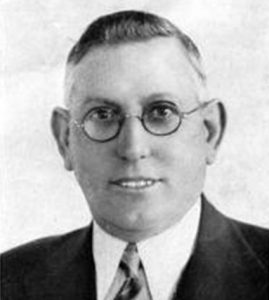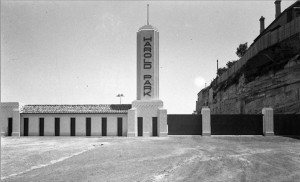Harold Park Scandal

‘Mick’ Emblem was an alderman who survived several Glebe Council scandals. First elected in December 1925, he was returned to office until 1941, but failed to gain preselection in 1944, the year of the last full election for the Council before its absorption by the City of Sydney in 1948.
Over the years Emblem allied himself with different Labor Party factions. Of the 12 aldermen elected in December 1925, 11 were Labor and most, like Emblem, Catholic. A supporter of Mayor Bill Walsh, a bookmaker who lived in the Toxteth estate, Emblem was re-elected in December 1928, four months after 29 candidates had vied for Labor preselection in ‘pantomime scenes’ at Glebe Town Hall. During the Depression NSW Premier’s Jack Lang’s proposal to withhold interest payments on British loans and reduce interest on domestic ones, the ‘Lang Plan’, split the State Labor Party from its Federal counterpart. In the 1931 and 1934 local government elections Emblem was a successful pro-Lang candidate, but in 1937, after Dr H J Foley had became Mayor and local Party boss, he contested for Foley Labor against State Labor. In 1939, following an investigation into its affairs, Glebe Council was sacked and an administrator appointed. In 1940 Emblem scraped in as a supporter of the McKell unity party ‘Official Labor’) in opposition to the Langites but lasted only one year. In another switch of allegiance, Emblem was one of the 12 candidates nominated by Lang in 1944 following the latter’s expulsion from the Labor Party. None of them won. In all, Emblem was a Glebe alderman 1925-39 and 1942-44. Unlike most of his fellow councillors he was not a Justice of the Peace.
Accusations of misconduct in the period 1926-9 when Bill Walsh was Mayor included ‘liquid refreshment’ as an expenditure item in the Mayoral allowance and the use of Council labour to repair the Mayoral home. It was during Emblem’s first term as an alderman that the NSW Trotting Club, owners of Harold Park, with no documented authorisation expanded their borders and encroached on public land, erecting turnstiles on Ross St and The Crescent.
In 1935, after Mayor Foley had moved to have the turnstiles and fences destroyed, Emblem was questioned in court about the events of 1927. He stated that he had no memory of a bribe being offered to Walsh by the Trotting Club. The matter was complicated by the Club’s claim that a lease existed, and that Foley and other aldermen had tried to extort a bribe of £1200 (£100 for each alderman) to drop the issue. The judge noted that Emblem’s recollections were ‘very vague’. After various court actions, the Trotting Club was, in May 1937, ordered to restore public access.

In 1938 a former Glebe Council employee brought an action against Foley, alleging breaches of the Local Government Act. An instance was the use of a Council car by Alderman Emblem for a trip to Springwood. In 1940 a report on Glebe Council was tabled in parliament after its affairs had been placed in the hands of an administrator. One finding was that for years Council engineer L Carey had been paying aldermen much of the commission he received on loan moneys spent on public works. Carey said this was under pressure from the aldermen on the grounds that he was already on a good wage and could afford to do so. The dealings had started in 1928 when Carey had given Mayor Walsh £30 to be split with aldermen Emblem and Cecil Dwyer (Emblem stated that Walsh had kept it all). In 1936 Carey made up individual envelopes containing cash and insisted that aldermen come in person to his office to pick them up. According to Carey all did so, with the exception of Emblem.
‘Mick’ or ‘Clarrie’ Emblem was born at Moruya, the son of William and Catherine Emblem, and christened Claret Joseph but had adopted ‘Clarence’ as his official first name by 1907 when he married Mary Ellen McMahon. Their three children, Mary Irene Nora, William Bryant and Rita May, were born in 1908, 1909 and 1911 respectively. The family lived in a wooden house in Corben St Surry Hills before moving to 61 Lombard St Glebe in 1917. From 1918 to 1932 they lived at 13 Hereford St. They then moved to other addresses nearby: 2 Victoria Rd, 182 Glebe Rd, 23 Acacia Rd, then 75 Wigram Rd. From 1955 until his death on 15 June 1961 Clarence lived at 2 Allen St. His widow, ‘Nellie’ died aged 78 on 25 March 1968.
Glebe was home to Clarence’s widowed mother who by 1921 had moved to 188 Bridge Rd with her son William Howard, a driver. At her death in 1935 the two were at 6 Hereford St. Other extended family members – surname Donnelly, Brunton, Comerford, Creevy – lived locally and worshipped at St James Church.
For most of his adult life Clarence Emblem worked as a ‘service marker’. It seems likely that his job was to place a mark where a utility was to be connected or repaired.
Sources: Australian Encyclopaedia; Cemetery records; Glebe Council Mayor’s Report 1937; Hogan, Michael Local Labor 2004; NSW births, deaths, marriages online registry; NSW electoral rolls; Sands directories; Solling, Max Grandeur & Grit 2007; Sydney Morning Herald 8.8.1928; 27.6.1935; 5.10.1938; 7.10.1938; 1.6.1939; 17.5.1940









There are no comments yet. Please leave yours.